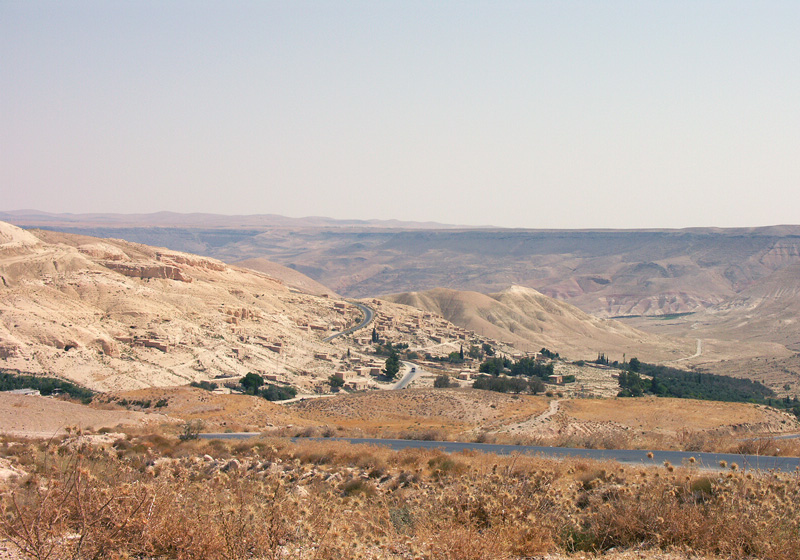The Architecture of Geology
The villages of Shobak have a special feeling of tidiness; their modern houses are neatly painted and usually completed. This feature makes Shobak a soothing contrast to the usual “modern” Jordanian village that often looks like an open-ended, uncoordinated construction site. After the village of Nijil, which has the most shops, on the road to Petra, and which is just to the south of the castle, the road starts climbing up until it passes by the oak-forested spot of Bir El Dabbaghat and Al Heesha.

The entire stretch of land between the castle and the point where the road starts descending to Wadi Musa, has a sharp ridge, hidden from the main road; an edge of stunning beauty known only to people of Shobak and to those with demanding curiosity.
Arriving at the edge, with the modern houses behind you to the east, you are now standing on a time line. Beyond this line, to the west, traditional village architecture has been forgotten and gone forever. In the foreground, few shrubs of “Sheeh”, Herba-alba Wormwood (Artemisia inculta), are pruned into bonsais by the severe climate and goats, emitting the strongest of scents at the touch of your feet. In the background, Wadi Araba appears as if from a satellite image of gigantic size and infinite resolution, in one-to-one scale, and at almost 45 degrees below the horizon. In the middle ground, you have to look twice; the houses of the village of Shammakh are hardly decipherable from the rock-cliffs of the monochromatic landscape. Typically, this traditional village was built of the very stone of the site. Its houses clinch to their location, following one rock stratum like plant roots. In Shammakh, the majority of houses are, in fact, semi houses-semi caves. The rock layer has acted as a building code, it gave the builders its inherent regulations and direction; geology acted as the village planner.
This rock layer, as in Shammakh, has provided suitable locations for most of the traditional village of the south, particularly those overlooking the Rift Valley. It is a layer of limestone and it sits directly on top of a sandstone layer. This limestone was formed from sediments under seawaters some 120 to 100 million years ago. It is part of the rock type under the general geological name “Ajloun Group” of the Cretaceous period, and is divided (from down upwards) into Na’ur, Fuhais, and Wadi Al Seer formations. These layers can be found in most of Jordan except for the southwestern region between Ras Al Naqab and Aqaba where they have been completely eroded due to the uplifting of that corner of the Kingdom. Towards the northeast of Jordan, these layers slope downwards and get buried deep under newer layers. The limestone of the “Ajloun Group” layers provided excellent, flint-free, building blocks for traditional villages such as Shammakh. It also facilitated the digging of caves that helped extending houses into the mountainside, making them more protected against the harsh climate. Finally, and most importantly, these rock-layers acted as water reservoirs that store rainwater and discharge it at springs. They store and distribute water along the line of villages all year round.
Shammakh was designed by geology, built a century ago by builders who followed the hints, material and lines of their site. Leaving for us an example of unique architecture, a village in harmony with the land, like wood-mushrooms growing out of an ancient tree trunk.
After passing the village of Nijil, near Shobak Castle, drive south for few kilometers on the road to Petra. To your right, west of the road, is the Shobak Agricultural College, you can turn right before or after the college heading west, past some houses until you reach the end of the relatively flat plateau and unexpectedly see the great depression of Wadi Araba. Ask for the village of “old” Shammakh. This destination can be combined with other Shobak villages as well as the castle. You can visit Shammakh on the way to Petra or after Dana. A full day or an overnight trip, spending the night in Dana or Petra. Good for children and for some hiking.